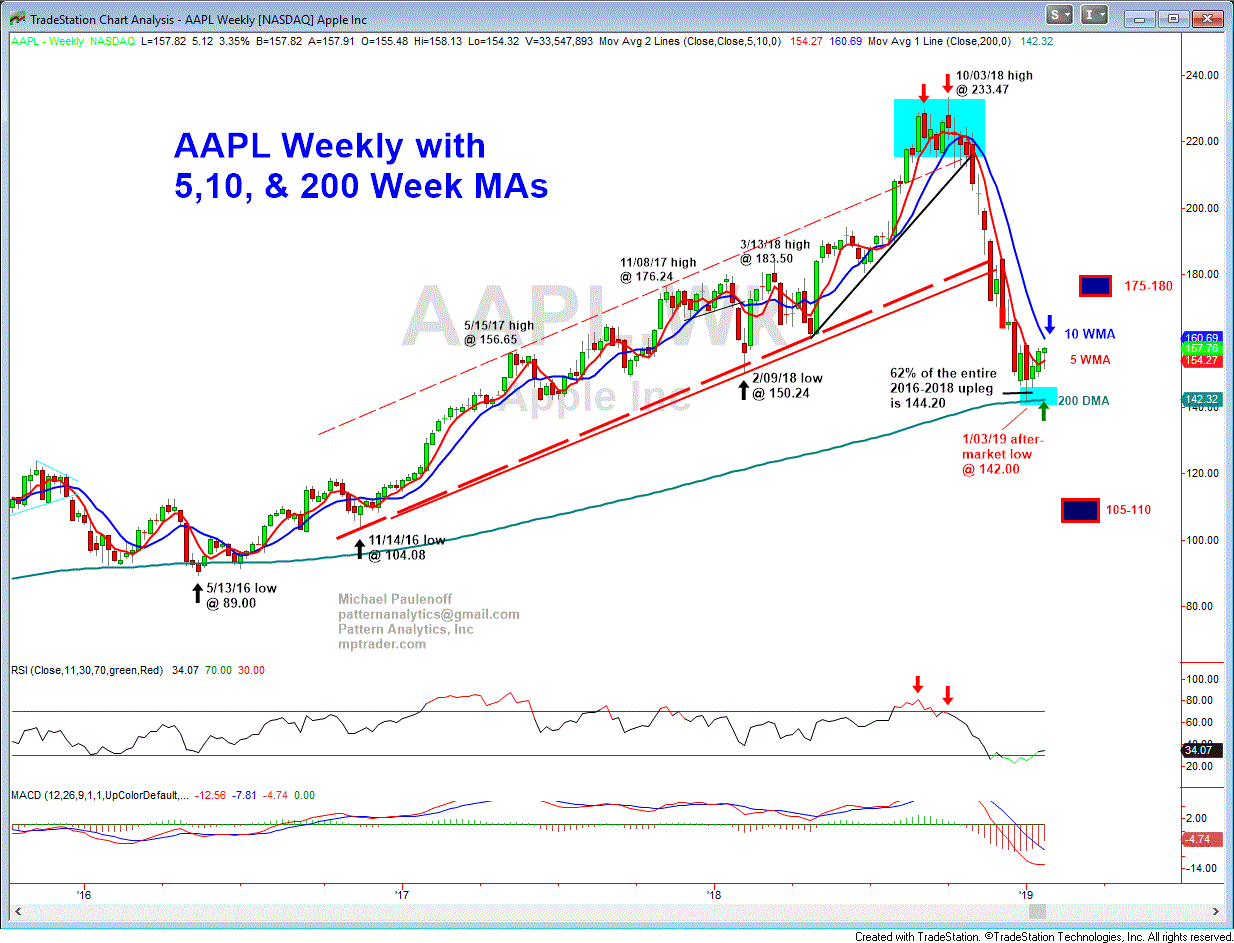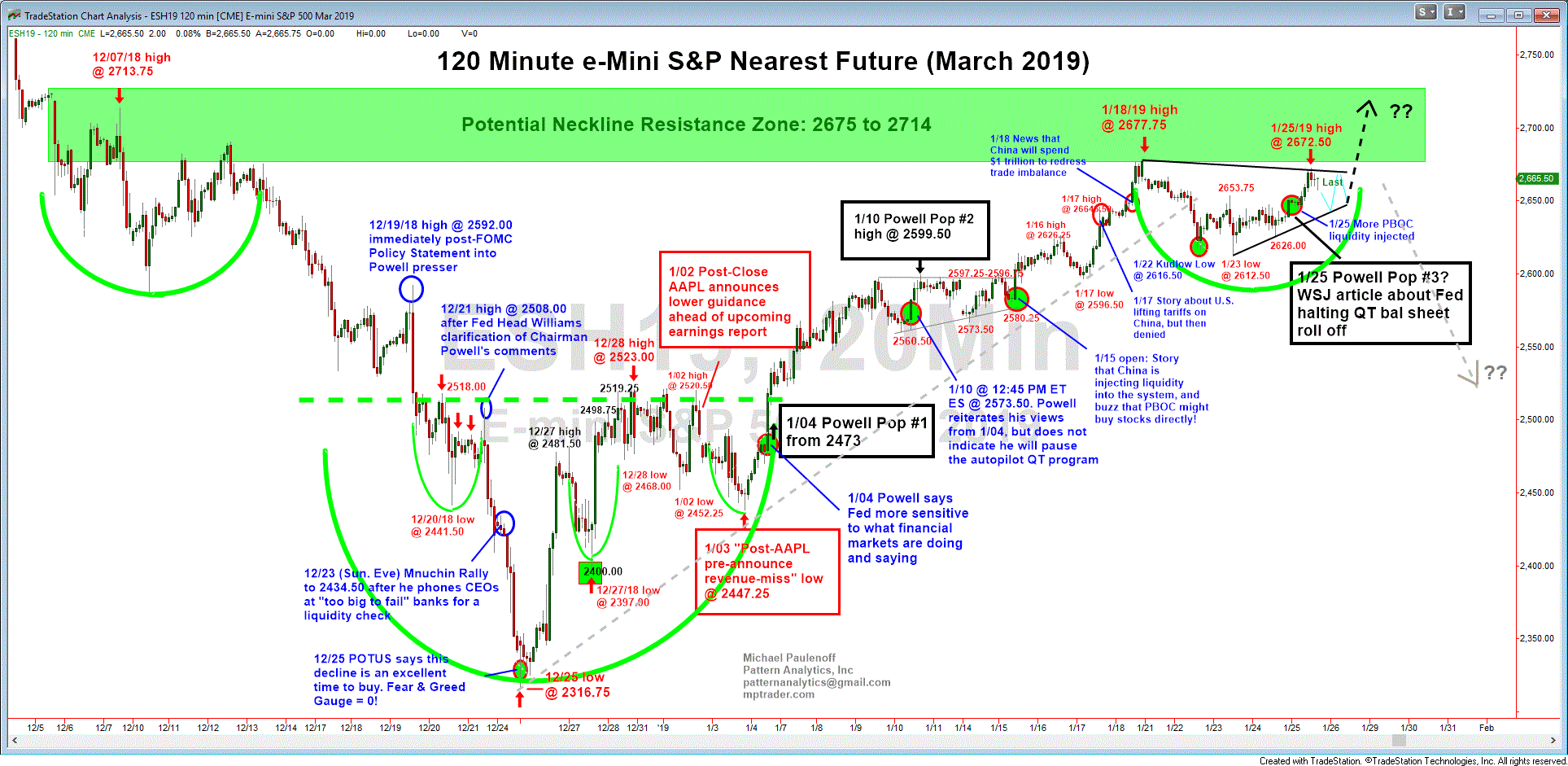Did AAPL Save the Fed, or Did the Fed Save APPL?
To my mind, though, the most consequential potential market-moving "events" will occur Wednesday afternoon starting at 2 PM ET, when the FOMC releases its next policy statement, and at 2:30 PM ET, when Fed Chairman Powell addresses reporters at the post-meeting press conference. The Fed will clearly have Apple Inc. (AAPL)'s earnings news from Tuesday after the bell on its mind.
This is because back on Jan 2 -- the first trading session of the new year -- AAPL pre-announced a shortfall in revenues for fiscal Q1, 2019. It was the first such slash in quarterly earnings in the past 15 years, mostly blaming the decline in iPhone demand on sluggish economic conditions in China (aka the US-China trade dispute).
While APPL has climbed 11% from its Jan 3 corrective low of 142 to last Friday’s close at 157.76, the stock has lagged the 14% rally in the S&P and the 16% post-Xmas rally in the NDX. AAPL’s faithful are nervous about the reaction of the stock to earnings, especially if there are any forthcoming surprises in The Street’s revised metrics, or from Tim Cook’s explanation of continued sluggish sales performance of the iPhone.
Technically, AAPL is at an important crossroads heading into Tuesday’s earnings news. After the company’s Jan 2 negative pre-announcement, the stock plunged to a Jan 3 multi-month low at 142.00, which tested and held two key technical levels: 1) the 62% retracement support zone of the entire 2016-2018 advance from 89.00 to 233.47, and 2) the 200 Week MA, now at 142.32, which has contained every significant bout of AAPL weakness since 2009.
Coincidentally or not, just hours after the AAPL pre-announcement bombshell and the stock’s plunge to a new multi-month low, on Jan 4 Fed Chairman Jay Powell joined a televised discussion with former Fed Chairs Bernanke and Yellen. They informed investors that the Fed’s future rate trajectory calling for 3 or 4 more 25 bp hikes during 2019 is not set in stone, and that the Fed intends to exhibit more patience, data dependency, and equity market sensitivity (my interpretation) in the upcoming weeks and months.
Could it be that after the major equity indices declined 20% in 13 weeks, triggering intense public pressure from the President and from high profile Wall Street "gurus," that a very negative and destabilizing earnings warning issued by AAPL on the first trading day of 2019 ultimately pushed Fed Chair Powell into a more accommodative mindset? After all, AAPL is a major component of all the benchmark indices as well as numerous sector and subsector ETFs, and has intricate ties to the performance of the Chinese economy (consumer). Let’s just say that neither APPL nor the equity indices have looked back since Powell’s accommodative remarks on Jan 4.
As fate would have it, the day after this coming Tuesday's earnings report from AAPL, Fed Chair Powell and his FOMC will find themselves front and center, and again in the crosshairs of investors. Could it be that the reaction of investors to AAPL’s report to some degree could impact Fed policy (again)?
Given the tenuous technical set up in AAPL shown on my weekly chart with the price structure boxed between a sharply declining 10 Week MA (160.69) and a horizonal 200 Week MA (142.32), we need to be mindful of the reaction to earnings.
If AAPL reacts negatively to earnings, and turns lower towards a retest and possible breach of its 200-week MA, the stock will trigger a disturbingly negative technical warning that will point the price structure to a next downside target zone of 105-110, which also could have far-reaching psychological and economic implications for investors. As such, AAPL’s price behavior will argue for additional “accommodation” from the Fed over and above what Powell and Company already have communicated to investors and markets during January.zx
Conversely, if AAPL reacts positively to earnings, and moves higher, challenging and/or hurdling the 10-week MA, either because the bad news already was fully discounted or because AAPL’s outlook is not as negative as expected, its price behavior is unlikely to influence (consciously or subconsciously) members of the FOMC.
In the case of a weaker-than-expected scenario for AAPL (perhaps connecting the dots to the China trade situation), will Powell be more compelled to announce a modification or cessation of the autopilot QT program, as was intimated by the Wall Street Journal’s article last Friday? If so, will the major equity indices respond accordingly (bullish)?
On the other hand, if AAPL is climbing strongly on Wednesday morning ahead of the FOMC announcement, propelling the stock indices with it, will that matter to Powell and his FOMC? Will the FOMC refrain from pulling back on QT? After all, the indices are up over 15% in the past month, gains that have been noticeably influenced by a more accommodative Fed perspective. Should such a scenario unfold, whereby Powell does not curtail QT, how will the markets respond?
ES Warns Us That More is at Stake
The price action in ES (e-Mini March S&P) since early December brings into focus what could be at stake this coming week, given intentional Fed "influence" since Jan 4, the day after AAPL’s earnings pre-announcement (shown in red on the chart). Additional Fed accommodation in whatever form -- from more jawboning about data dependence to a complete halt of Quantitative Tightening, to possible hints from Powell that he is not averse to reducing rates if conditions warrant -- all could feed into an extended, powerful renewal of an easy money, bullish narrative that has potential to propel ES up to and through the 2700 to 2715 December-January resistance zone.
If such a climb unfolds, then the price action since early December could be viewed as a big, impressive, and consequential accumulation-base formation that projects MUCH HIGHER prices in the subsequent days and weeks. Upside swing targets range from 2910 to 3000!
As is always the case, however, there is a counter argument that also can be made. What if the newly "accommodative" Powell Fed is all talk but takes little if any actual action to reverse perceptions that its intention and objective are to "normalize" a central bank policy that no longer should be or needs to be in crisis mode? What if Powell’s recent back-pedaling, while exhibiting more data dependency and sensitivity to volatility in the equity markets, nonetheless remains resistant to returning to the super easy money ways of years past, which can be blamed for asset bubbles, as well as acute income and wealth disparities?
If in reaction to Wednesday’s FOMC Policy Statement and Powell press conference, the equity indices respond negatively (regardless of what AAPL is doing), and ES fails to climb up through 2680-2715 and instead reverses down through 2626-2612 support, then traders and investors will be signaling that the Fed-supportive jawboning period has been fully-discounted, and is transcending into a "show me" phase.
In other words, unless and until the Fed "walks the walk" of easier money in some way or other, the post-Christmas advance will find itself in jeopardy.


